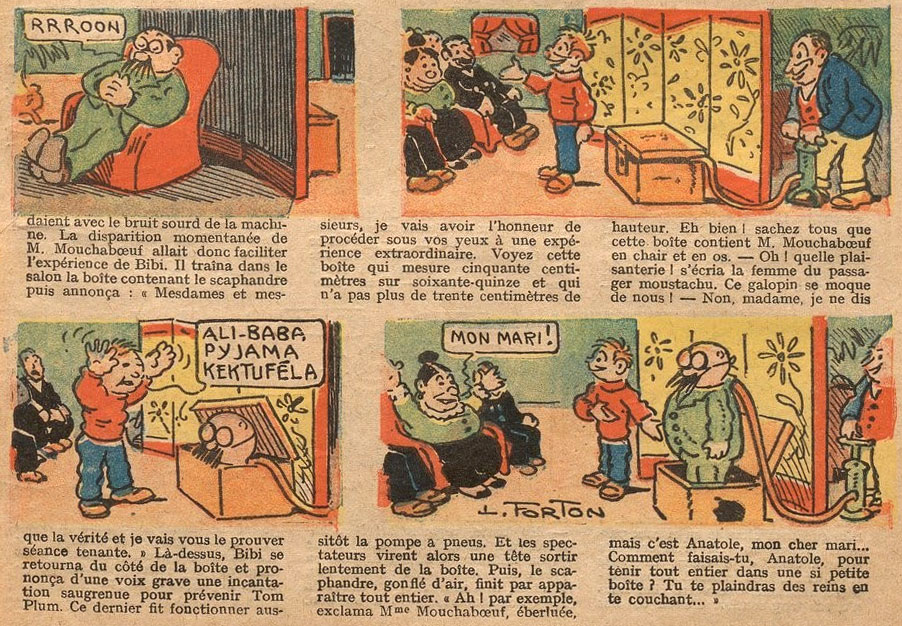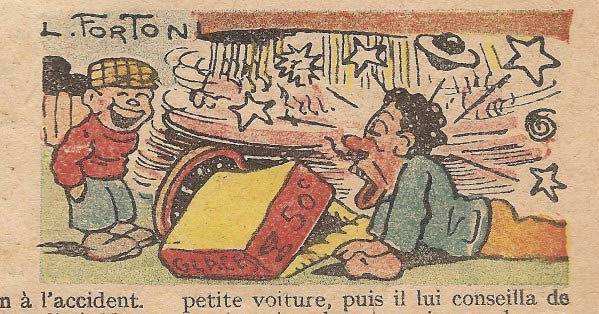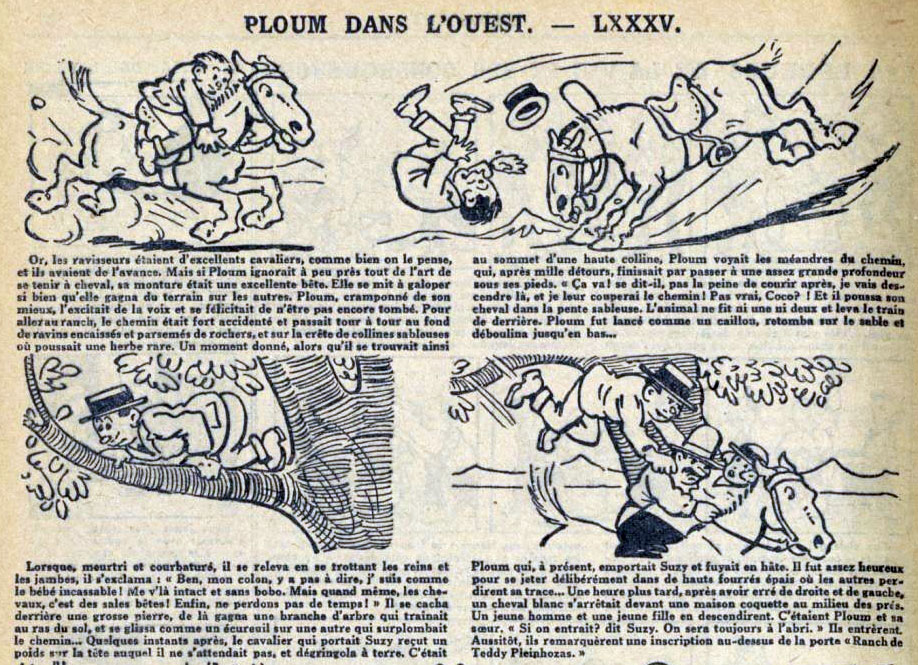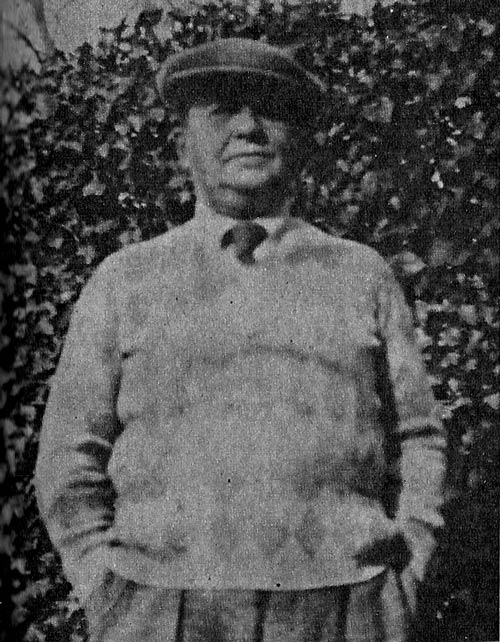Louis Forton was one of the pioneers of French comics and the creator of the classic series 'Les Pieds Nickelés' (1908-1934) and 'Bibi Fricotin' (1924-1934). Alongside contemporaries such as Louis Tybalt, Raoul Thomen, Marcel Arnac and E. Nicolson, he was one of the major contributors to the early 20th century magazines of the Offenstadt brothers, most notably Le Petit Illustré and L'Épatant. Forton was renowned for his amusing drawing style and subversive streak, particularly in his signature series 'Les Pieds Nickelés', with its stance against aristocrats and politicians. Over the decades, a great many comic artists have rebooted the adventures of the three scoundrels Ribouldingue, Filoch and Croquignol, making 'Les Pieds Nickelés' (1908-2015) the longest-running French comic series of all time, followed by Jo Valle and André Vallet's 'L'Espiègle Lili' (1909-1998). Together with Émile-Joseph Pinchon's 'Bécassine' (1905), Forton's 'Les Pieds Nickelés' were at the vanguard of the modern French comic strip with a recurring cast of characters. After their creator's death, both 'Les Pieds Nickelés' and Forton's long-running children's adventure series 'Bibi Fricotin' (1924-1988) have been adapted into live-action films.
'Bibi Fricotin Fait le Tour du Monde' (1933).
Early life and career
Louis Adolphe Forton (some sources erroneously say "Louis Alphonse Forton") was born in 1879 in the small town of Sées, Orne, in the Normandy region. As the son of a horse salesman, it was only natural that he originally worked as a racehorse jockey. At one of the races, he met the Offenstadt brothers, who were well-known magazine publishers at the time (their firm was later known as the Société Parissienne d'Édition). The brothers planned to launch a children's magazine and since Forton had a talent for drawing, he was hired as one of its illustrators. In May 1904, Forton debuted as a graphic artist in the Offenstadt magazine L'Illustré, creating the comic strip 'L'Histoire du Sire de Ciremolle' (issue #6, 10 July 1904). The magazine folded only two years later, but was quickly replaced in November 1906 by Le Petit Illustré, with Forton becoming one of its leading contributors. During the same period, Forton made humorous illustrations for the military magazines La Vie en Culotte Rouge and La Vie de Garnison, and was also present in Polichinelle magazine, published by Flammarion and Le Petit Illustré Amusant, published by Fayard.
L'American Illustré
In 1907 and 1908, Forton also appeared in the 40 issues of the magazine L'American Illustré by the Parisian Librairie Mondiale, creating his first notable comic characters under Anglo-Saxon pseudonyms like Tom Hatt, Tommy Jackson and W. Paddock. His first contribution was 'Les Aventures de Séraphin Laricot' (1907). Debuting on 29 June 1907, the title character is a tramp who tries to survive by begging, stealing and taking short-lived jobs. Although the series already concluded on 30 November of that same year, the Librairie Mondiale compiled all episodes in a 1907 book. Forton's next comic in L'American Illustré was 'Ce P'tit Namour d'Enfant'. Serialized between 30 November 1907 and 28 March 1908, the gag comic centers on a family and their obnoxious child. Stylistically, it is very reminiscent of George McManus's U.S. newspaper comic 'The Newlyweds' (1904-1912). Forton continued working with impoverished characters in his next series, 'Les Exploits d'Isidore Mac-Aron et d'Anatole Fricotard' (11 January - 28 March 1908). Isidore and Anatole are two crooks, who usually get their comeuppance in the end. They can be considered an embryonal version of Forton's later characters, Les Pieds Nickelés.
Cover illustrations for L'Épatant, respectively 28 February 1911 and 4 August 1916.
Les Pieds Nickelés
In April 1908, Forton also became the main artist of L'Épatant, a new magazine launched by Offenstadt (the first issue was a free supplement to Le Petit Journal). Forton created numerous covers and illustrations. In the ninth issue of 4 June 1908, the first episode of 'Les Pieds Nickelés' saw print. The series stars three work-shy vagabonds and the title ("The Nickel Feet") refers to their sensitive feet "which shouldn't be used for any hard or difficult work". Ribouldingue has a black beard. Filochard wears a mustache and has an eyepatch. Croquignol is the bald and pointy-nosed leader of the gang. Many storylines feature the threesome looking for food or money and getting themselves into trouble for it. Their main adversaries are police chief Croquenot and Inspector Duflair, who constantly try to arrest them. Even though the series was created in the early European tradition with text captions underneath the images, Forton went through great lengths to convince his editors to be allowed to add speech balloons to some of his panels.
'Les Pieds Nickelés Contre le Kaiser', featuring a cameo of German emperor Wilhelm II.
Les Pieds Nickelés: success
Right from the start, 'Les Pieds Nickelés' was a tremendous success. Readers liked the trio's humorous adventures, which often ridiculed the police, judges, aristocrats, military officers and politicians. Some were even caricatures of the real-life rich and famous, for instance the President of France and the English king. While Forton apparently wasn't drafted during the First World War, his characters did join the army. They fought the German army ("Les Boches") and even Kaiser Wilhelm II in person. Doing their patriotic duty, 'Les Pieds Nickelés' grew even more popular with their French audience.
Thanks to their anarchic reputation and tendency to keep up with the times, 'Les Pieds Nickelés' were guaranteed a long lifespan. From 1905 on, they inspired various book collections. Although he had a big production, Forton still took time off to enjoy himself. He worked during the morning, and then headed for the horse races in Paris. As a result, serialization of 'Les Pieds Nickelés' was frequently interrupted, and readers of L'Épatant often had to wait several weeks until the story was continued.
In 1917 and 1918, the French animation pioneer Émile Cohl directed five animated shorts starring 'Les Pieds Nickelés' for the Société Éclair. Together with Cohl's animated adaptations of Benjamin Rabier's comics, they rank as the first film adaptations of a French comic strip. Marcel Aboulker directed the live-action comedy film 'Les Aventures des Pieds-Nickelés' (1948) and its sequel 'Le Trésor des Pieds-Nickelés' (1950). Fourteen years later, another live-action film adaptation came out: 'Les Pieds Nickelés' (1964), directed by Jean-Claude Chambon.
La Jeune France
In addition to his main series, Louis Forton continued to contribute to other magazines. One of them was La Jeune France (subtitled "Histoire Illustrée de la Guerre 1914-15-16"), a patriotic magazine published during the World War I years. In 1916 and 1917, Forton created several one-shot picture stories and gag strips for this magazine, using the traditional text comics format. 'Le Ventillateur-Chasse-Mouche-Aéro-Hydroplane' (5 March) follows the exploits of a mad inventor and his wacky flying machine. Forton used a dim-witted soldier character named Cancrelat in two gags. In 'Chacun Son Tour' (9 April), Cancrelat runs to a soldier standing guard and asks him to be allowed inside. Thinking it's time to change the guard, the soldier lets him in, but it turns out Cancrelat mistook the cabin for a toilet. Cancrelat blunders again in 'Fâcheuse Aventure' (16 April), when his head gets stuck in a jar. Since it cannot be lifted, a face is painted on the object, to fool his officers. In 'Curiosité Punie' (28 May), a curious museum visitor gets his nose stuck between a knight's helmet, while in 'Bagoulet n'a Pas La Main Heureuse' (4 June), a burglar tries to open a safe, but is shocked to find a policeman inside. Forton's final comic for La Jeune France appeared in the 18 July 1917 issue, and featured a butler sawing off the legs of his master's table as a trick.
Le Pêle-Mêle
Louis Forton also remained a contributor to other Offenstadt magazines. In Le Pêle-Mêle, Forton drew more gags with speech balloons. In 'Je Veux Photographer Kiki' (1 June 1924), a dog owner tries in vain to photograph his pet. A hairdresser in 'Le Coiffeur est Distrait' (15 June 1924) daydreams about a sexy woman and accidentally cuts his client bald. 'Idylle Interrompue' (10 August 1924) features a couple trying to get even with an aggressive rhino in the zoo. The gag in 'Une Idée Ingénieuse' (8 February 1925) is basically promotion for Le Pêle-Mêle, with a character putting glue and sand on the wall, to write an advertising slogan.
'Bibi Fricotin' (1928).
Bibi Fricotin
On 5 October 1924, Forton temporarily interrupted 'Les Pieds Nickelés' to launch his second big series, 'Bibi Fricotin'. Appearing in the Offenstadt magazine Le Petit Illustré, Bibi was originally a puny and lazy farm boy, working for his uncle Isidore. In most gags, the kid devotes far more energy to playing tricks on his relatives, farm animals and other people in his surroundings. Originally a gag comic, 'Bibi Fricotin' quickly evolved into an adventure serial. Bibi lost his trickster tendencies and became a more quick-witted and resourceful boy. He subsequently joins a circus, travels around the world and works as a journalist and detective. Forton continued creating the adventures of 'Bibi Fricotin' until his death in 1934.
During its heyday, 'Bibi Fricotin' enjoyed considerable popularity. In 1951, Marcel Blistène directed the live-action film adaptation 'Bibi Fricotin', with a still unknown Louis de Funés in one of the supporting roles.
'Ploum dans l'Ouest' (L'Épatant, 12 August 1926).
Ploum
With 'Les Pieds Nickelés' on hiatus in L'Épatant, Forton contributed a new comic to the magazine: 'Les Aventures de Ploum' (1925-1927). 'Ploum' is a humorous adventure comic, serialized in episodes. Although it follows a text comic format, some images do use speech balloons. The title character was physically modeled after the Hollywood comedian Monty Banks, who, back then, was named 'Ploum' in France.
Later years and death
In 1927, Forton resumed the adventures of 'Les Pieds Nickelés', and continued to draw them until his death. Some of his additional picture stories in both L'Épatant and Le Petit Illustré were created under the pen name Piccolo. In the meantime, Forton also continued to provide artwork to magazines like La Vie de Garnison, Mon Copain du Dimanche (1911), Le Croix d'Honneur (1918) and Fillette. Between 1931 and 1934, Forton cooperated on the advertising magazine La Revue du Cires Sultanes, along with artists like Gaston Callaud, Maurice Cuvillier and Tybalt.
A heavy drinker and a solid gourmand, Forton had to undergo surgery for cirrhosis of the liver on 15 February 1934, and died on the operating table of a Saint-Germain-en-Laye clinic.
'Les Pieds Nickelés Ont La Belle Vie'.
Posthumous continuation of Les Pieds Nickelés
Until his death, Louis Forton had continued to draw both 'Les Pieds Nickelés' and 'Bibi Fricotin', and both series were continued in decades to come. After World War II, the Société Parissienne d'Édition gave both Forton's characters their own magazines. Le Journal des Pieds Nickelés appeared from 1948 to 1951, and again from 1964 to 1976, while Le Journal de Bibi Fricotin ran from 1965 to 1976.
The 'Les Pieds Nickelés' comic was at first briefly continued by Aristide Perré (1934-1938) and Albert Georges Badert (1938-1940). During his post- World War II from 1948 until 1981, the illustrator René Pellos brought the series to new heights, often in collaboration with scriptwriter Roland de Montaubert. Pellos notably fleshed out the characters. He made Ribouldingue a sympathetic doofus, Filochard short-tempered and Croquignol the smartest of the three. He also gave the characters distinctive clothing and new designs. He remained the series' principal illustrator for four decades, with only a brief interval between 1953 and 1954 when Pierre Lacroix made three stories with the characters.
During the 1980s, new adventures of 'Les Pieds Nickelés' were created by successively Jean-Louis Pesch (1981), Jacarbo and Serge Saint-Michel (1982-1983), Jicka (1984-1988), Laval, Claderes and Gen-Clo (1988). Three years later, Michel Rodrigue, aided by Mike Deporter and Thierry Capezzone, created a reboot for publisher Vents d'Ouest, named 'Les Nouvelles Aventures de Pieds Nickelés' (1991-1992). André Juillard and Didier Convard took a more personal shot at the characters with 'Les Pieds Nickelés - Demain Sera Un Autre Jour' (Dargaud, 1999). The century-old franchise lay dormant throughout the first decade of the 21st century, but was revived between 2009 and 2012 by Trap and Stéphane Oiry for publisher Delcourt.
In 2010, various artists were asked to create their personal take on 'Les Pieds Nickelés'. The end result, the anthology book 'Les Nouveaux Pieds Nickelés' (Onapratut, 2010), featured contributions by Michaël Baril, Aurélien Bédéneau, Fabien Bertrand, Paul Burckel, Ced, Clotka, Dib, François Duprat, Frédéric Duprat, Elric, Filak, Stéphane Girod, Olivier Ka, Loco, Lommsek, Alejandro Milà, Pasto, Radi, Loïc Senan, Thibaut Soulcié, Unter, Waltch, Wayne, Wouzit, Carali, Caza, Hardy, Hugot, Lamorthe, Laurel, Étienne Lécroart, Thierry Martin, O'Groj, Obion, Nancy Peña, Jeff Pourquié, Olivier Schwartz, Al Séverin, François Walthéry and Marc Wasterlain. Pascal Rabaté designed the cover. Since the 2010s, Philippe Riche, Richard Malka, Ptiluc, Luz, Corteggiani, Herlé, Gérald Forton (the artist's grandson), Julien Moca, Jihel, J.P. Tiberi and Bévé have also created their own versions of the classic trio.
Posthumous continuation of Bibi Fricotin
After Forton's passing, 'Bibi Fricotin' was continued by Gaston Callaud from 1934 until the Nazi invasion of France in 1940. The series went into hiatus for seven years. After World War II, 'Bibi Fricotin' was relaunched in 1947 by Forton's former assistant Pierre Lacroix. For the next four decades, scripts were provided by Maric, René Lortac and Roland de Montaubert. In 1950, Lacroix enriched the series with a new cast member, the black boy Razibus Zouzou, who became Bibi's best friend and sidekick. The 'Bibi Fricotin' series lasted until 1988. In the 21st century, writer André Manguin and artist Claude Turier made a new book called 'Bibi Fricotin et les Sumos' (Éditions Aarsinoë, 2010). In 2014, Louis Forton's grandson Gérald Forton and writer Stephan Borrero also made a new book with the character for Éditions Joe.
Legacy
With two of the most enduring French comic series to his name, Louis Forton stands as one of the pioneers of European comics. By switching to the balloon comic format, he also innovated the medium in his home country. The legendary cartoonist has been named an influence by René Goscinny, Tomi Ungerer and Milorad Dobrić. A celebrity fan of 'Les Pieds Nickelés' was Belgian painter René Magritte. Forton's legacy also continued in Belgium through his grandson Gérald Forton (1931-2021), who became a prominent comic artist in his own right during the second half of the 20th century.
Louis Forton.















